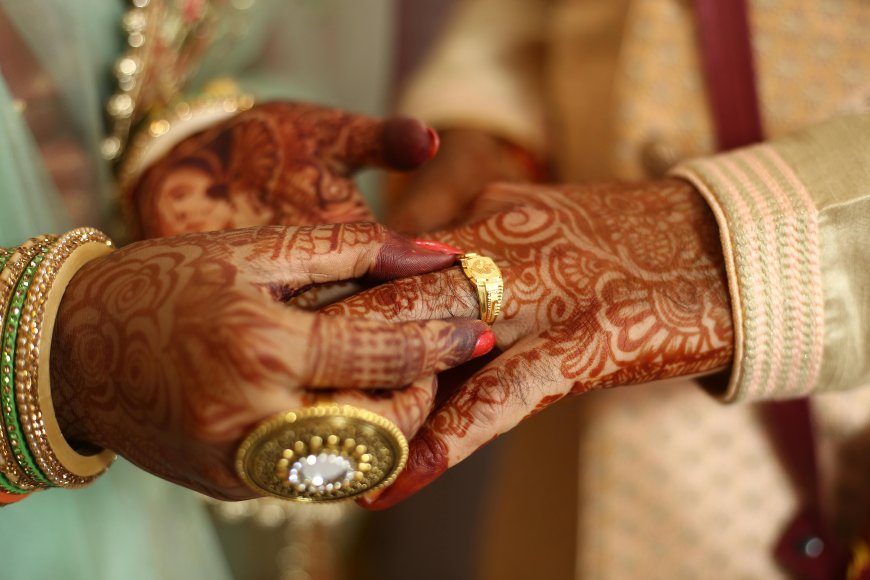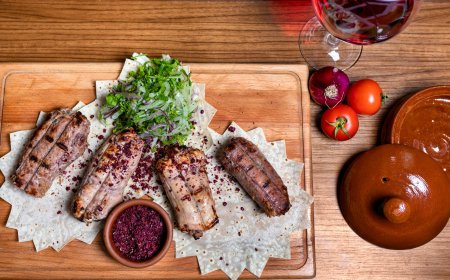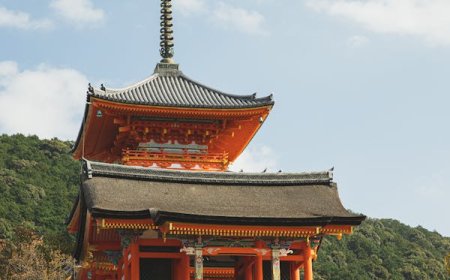The prominent Indian wedding traditions
Indian wedding traditions constitute a rich cultural experience that includes multiple rituals such as engagement ceremonies involving the exchange of rings and gifts, Mehendi rituals which involve applying henna on the bride's hands, Sangeet which is considered an entertainment event bringing both families together for singing and dancing, in addition to Hindu rituals like Pooja and Vivaah, and ceremonies such as the exchange of vows, the departure, and reception rituals.

Indian wedding traditions constitute a rich cultural experience that includes multiple rituals such as engagement ceremonies involving the exchange of rings and gifts, Mehendi rituals which involve applying henna on the bride's hands, Sangeet which is considered an entertainment event bringing both families together for singing and dancing, in addition to Hindu rituals like Pooja and Vivaah, and ceremonies such as the exchange of vows, the departure, and reception rituals.
The prominent Indian wedding traditions
Exploring Indian wedding traditions means delving into the unique cultural customs and practices that distinguish weddings in India. Indian wedding traditions are among the richest and most diverse in the world, reflecting family, religious, and societal values. These traditions comprise a series of rituals and ceremonies followed by the bride and groom and their families before, during, and after the wedding.
Indian wedding traditions encompass a variety of activities and ceremonies, ranging from engagement rituals to reception rituals. In engagement rituals, rings are exchanged between the bride and groom, and gifts are exchanged between the families as a sign of respect and appreciation.
Following this are the Mehendi rituals, where henna is applied to the bride's hands and sometimes her feet, symbolizing beauty and purity. This is followed by the Sangeet ceremony, which is one of the most enjoyable events in Indian weddings, featuring singing, dancing, and celebrating the joy of marriage.
Hindu rituals include the Pooja and Vivaah ceremonies, where prayers are offered to the gods and goddesses, and vows are exchanged between the bride and groom in front of the gathering. After the wedding, the rituals of departure and farewell come into play, as the bride bids farewell to her family and joins her husband's family, culminating in the reception where relatives and friends offer congratulations and exchange blessings.
In this way, exploring Indian wedding traditions reflects the richness and diversity of Indian culture, emphasizing the importance of family and traditions in Indian society.
The beauty and diversity of Indian wedding traditions and their significance in society
Indian wedding traditions are an integral part of Indian culture, distinguished by their unique beauty and diversity. Indian weddings reflect many values and principles that form the foundation of society, promoting social cohesion and familial bonds. The importance of these traditions manifests in several aspects:
1. Social cohesion: Indian wedding traditions integrate individuals into society and foster social cohesion, as relatives and friends participate in all stages of the ceremonies and rituals. Marriage is seen as an occasion for communication and cultural exchange among different families.
2. Heritage preservation: Indian wedding traditions are an important part of the country's cultural heritage, contributing to the preservation and transmission of this heritage to future generations. By adhering to ancient rituals and traditions, importance is given to Indian history and culture.
3. National identity enhancement: Indian weddings provide an opportunity to enhance national identity and belonging to the country, as various communities and cultures come together to celebrate love and solidarity.
4. Family values promotion: Indian wedding traditions promote family values and strengthen bonds between family members, as marriage is considered not only a union between two individuals but between two families and cultures.
5. Local economy boost: Lavish wedding ceremonies stimulate the local economy by consuming food, clothing, decorations, and party services, thereby boosting commercial activity in the region.
In this way, Indian wedding traditions are an important part of Indian culture, heritage, and society, playing a vital role in promoting social cohesion and cultural solidarity.
Narrating the journey of lovers
Narrating the journey of lovers within the context of Indian wedding traditions reflects a love story filled with romance and rich cultural traditions. This journey consists of a series of events and ceremonies that refine the relationship between the lovers and bring them closer together, ultimately leading to marriage and the union of their families. Here is a narrative of some stages of this journey
1. The meeting of the lovers: The journey of the lovers begins with their first encounter, a special moment where fate brings them together and they embark on their love journey.
2. Courtship and bonding: The lovers exchange conversation and ideas, getting to know each other on a deeper level, as sympathy and attraction grow between them.
3. Engagement and engagement rituals: After the lovers reach the decision to marry, rings are exchanged, and gifts are presented between the families, with an engagement ceremony celebrating the union of the lovers.
4. Wedding rituals: This stage includes a series of rituals and ceremonies that take place during the wedding ceremony, such as Mehendi rituals, Vivaah rituals, Pooja, and the exchange of vows.
5. Post-wedding rituals: After the wedding, the lovers face a new stage in their lives together, which includes the bride visiting the groom's family home, conducting reception ceremonies, and welcoming rituals.
6. Beginning of married life: The lovers embark on a new adventure together, uniting to build a life based on love, understanding, and respect.
The journey of lovers in Indian wedding traditions varies according to local culture and traditions, but ultimately embodies a unique and exciting love story that combines romance and ancient traditions.
Sangeet details
Sangeet details are an important and distinctive part of Indian wedding traditions, as this social event is considered one of the most enjoyable and festive events leading up to the wedding. The Sangeet ceremony is characterized by singing, dancing, music, games, and joy, with all family members and friends contributing to the celebration and happiness of this special occasion.
Preparations for the Sangeet ceremony begin early, with selecting the appropriate venue and organizing all the details to ensure the smooth flow of the event. The venue is decorated with vibrant colors and beautiful decorations to create a festive atmosphere filled with joy and happiness.
The traditions that distinguish the Sangeet ceremony include:
1. Singing and dancing: Family members and friends present traditional and modern songs and dances, and everyone participates in dancing to lively music beats that add a special atmosphere to the event.
2. Competitions and games: Entertainment games and competitions are organized to add more vitality and fun to the ceremony, with attendees enthusiastically participating in these entertainment segments.
3. Performance shows: Sangeet details may include performances of theatrical arts or folk arts, such as poetry recitations or visual arts, to add an artistic touch to the event.
4. Food and beverages: Serving food and beverages is an important part of the Sangeet ceremony, with a variety of delicious Indian cuisines and traditional desserts offered to please all attendees.
5. Moments of joy and welcome: The Sangeet ceremony includes moments of welcome and congratulations to the bride and groom by relatives and friends, with everyone expressing their joy and best wishes for a happy married life.
In this way, the Sangeet ceremony is an integral part of Indian wedding traditions, embodying joy and happiness and bringing together family and friends to celebrate the arrival of the bride and groom.
Hindu rituals in weddings
Hindu rituals in weddings constitute an essential part of Indian wedding traditions, where these religious rituals are considered among the most significant aspects that distinguish Indian weddings. These rituals provide an opportunity for prayers and blessings for the couple and secure divine blessings for their married life together. Here is a detailed overview of some key Hindu rituals in weddings:
1. Puja: This is a religious ceremony performed at the beginning of the wedding where prayers and offerings are made to the gods and goddesses. This ritual is an occasion to seek blessings and divine favor for the couple before they embark on their married life together.
2. Vivaha (Vivah): In this ritual, vows and promises are exchanged between the couple in front of the attendees and witnesses of the wedding. The couple exchanges questions and answers reaffirming their readiness to commit to building a life together.
3. Saptapadi (Seven Steps): This ritual is one of the most important symbols of marriage in Hinduism, where the couple takes seven steps together symbolizing the seven vows and commitments they make before the gods and the assembly.
4. Homam (Hom): This ritual involves burning herbs and natural substances in a sacred fire, and the couple may offer sacrifices to the gods during this process, seeking blessings and prosperity for their new life.
5. Mandap: In this ritual, a sacred platform decorated with flowers and beautiful fabrics is constructed, where the main wedding ceremonies take place.
These rituals vary according to different Hindu sects and traditions, reflecting the beauty and depth of religious culture in India and its vital role in embodying the spirit of dedication and commitment between the couple.
Mandap rituals and the beauty of henna
Mehndi rituals and the beauty of henna are considered integral parts of Indian wedding traditions, representing both aesthetic and cultural aspects inseparable from wedding celebrations. Henna plays a significant role in the bride's experience, symbolizing beauty, tenderness, and prosperity.
The Mehndi rituals begin with the preparation of the henna paste, which is then applied to the bride's hands and sometimes her feet and other parts of her body. This application is part of the wedding preparation and is believed to bring good luck and success to the bride in her married life.
The designs of the henna adorn the bride's hands with intricate and diverse patterns reflecting India's cultural heritage, varying from region to region. These designs include geometric patterns, flowers, and traditional Indian motifs such as paisleys, peacocks, and mango motifs. Often, the groom's name is also drawn on the bride's hand, which holds special significance in Indian wedding traditions.
Mehndi rituals are characterized by festive atmospheres, where women from the bride's family and closest friends come together to celebrate this special occasion. The celebration often involves singing, dancing, storytelling, and laughter, making it a moment that combines beauty, joy, and ancient traditions.
In this way, Mehndi rituals and the beauty of henna are integral parts of Indian wedding traditions, embodying beauty, spirituality, and joy in this special occasion.
Farewell and reception traditions in Indian weddings
The farewell and reception traditions in Indian weddings are among the most emotional and impactful moments in the celebration, marking a significant transition in the lives of the bride, groom, and their families. The farewell, known as the 'Vidai,' is a moment for bidding farewell to the bride as she leaves her parental home to join her husband's home, while the reception signifies the beginning of a new journey for the couple as spouses.
The farewell ceremony is typically organized a day or two before the wedding day, where the bride's family and friends gather to bid her farewell and offer their best wishes for her future life. It may include soft music, moments of silence, prayers, and reflection, often bringing tears to the eyes of family and friends in this emotional event.
On the other hand, the reception takes place on the wedding day itself and is filled with joy and celebration. It is held in a large hall with delicious food, drinks, live music, and dancing. Relatives and friends attend to congratulate the newlyweds and exchange blessings, making these moments full of happiness and delight.
The farewell and reception traditions in Indian weddings vary based on culture and region, but the main goal is to bid farewell to the bride and welcome her into her husband's family with love and appreciation. These moments are integral to Indian wedding traditions, symbolizing a new phase in the lives of the bride and groom, and marking the beginning of a new journey together as loving spouses.
Summary
The traditions of Indian weddings are an integral part of the country's rich cultural heritage, reflecting the values of religion, family, and society. These traditions vary between religious, social, and aesthetic rituals, making each wedding ceremony unique and distinctive in its own way. Indian wedding traditions include rituals such as engagement, mehndi, and sangeet, in addition to Hindu rituals like puja and vivaha, and the farewell and reception rituals. These traditions are social occasions that bring together family and friends to celebrate love, unity, and new beginnings, embodying the spirit of unity, tolerance, and happiness in Indian society.
Sources
1. Indian Ministry of Culture Website This website can provide useful information about Indian wedding traditions and accompanying rituals.
2. Britannica Encyclopedia Offers comprehensive articles on Indian culture and traditions, including marriage.
3. India Wedding Website Provides articles and resources related to weddings in India, including traditions and customs.
What's Your Reaction?



















































































































































